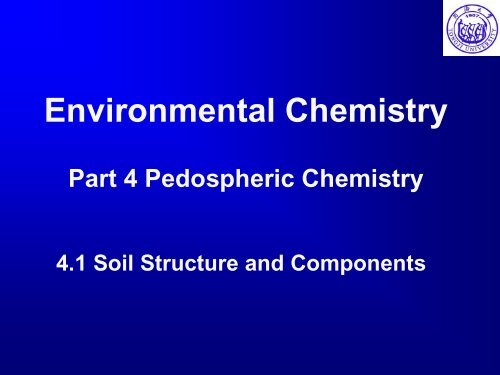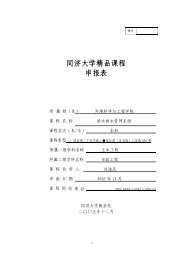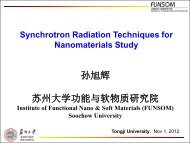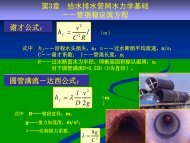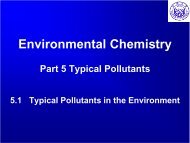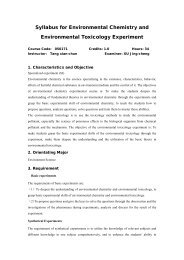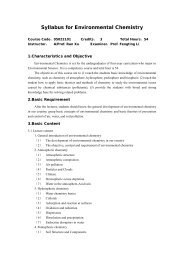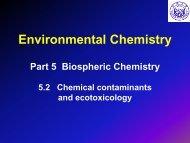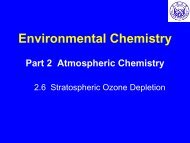Environmental Chemistry
Environmental Chemistry
Environmental Chemistry
You also want an ePaper? Increase the reach of your titles
YUMPU automatically turns print PDFs into web optimized ePapers that Google loves.
<strong>Environmental</strong> <strong>Chemistry</strong><br />
Part 4 Pedospheric <strong>Chemistry</strong><br />
4.1 Soil Structure and Components
4.1<br />
土壤组成<br />
(Soil Components)<br />
4.1.1 土壤化学组成 (Chemical components of soil)<br />
Fig. 4.1 structure of solid, liquid<br />
and gas phases in soil<br />
Soil:multiphase system (solid, liquid, gas)<br />
– lithogenic,biogenic,atmogenic and<br />
hydrogenic components<br />
Solid phase in soil:soil minerals (90%,<br />
including primary and secondary<br />
minerals), organic matters(1%-10%)<br />
and organism<br />
Liquid phase in soil:water and its<br />
solutes<br />
Gas phase in soil:between the matters<br />
in different phases exist holes and<br />
gaps (taking up 35% of the whole<br />
volume of soil) where are filled with air<br />
The ratio of matters in three phases in<br />
soil: mainly in solid phase, the relative<br />
amount of matters in other two phases<br />
depends on the conditions.
Fig 4.2 the general ratio of different components in<br />
silty soil (粉砂土壤)<br />
Most soils contain four basic components: mineral particles, water,<br />
air, and organic matter. Organic matter can be further sub-divided<br />
into humus, roots, and living organisms. The values given above are<br />
for an average soil.
Soil layer<br />
Overburde<br />
n layer (A 0 )<br />
Eluvial<br />
layer (A)<br />
Illuvial<br />
layer(B)<br />
Parent<br />
material<br />
layer (C)<br />
Bedrock<br />
(D)<br />
Typical soil stratification<br />
A 00<br />
A 0<br />
A 1<br />
A 2<br />
A 3<br />
B 1<br />
B 2<br />
B 3<br />
D<br />
C C<br />
C S<br />
C T<br />
Loose litter layer, undecomposed<br />
Dark hemic oranic matter layer<br />
Dark humus layer<br />
Offwhite podzol layer<br />
Transition layer to B layer,<br />
similar to A layer<br />
Transition layer to A layer, similar to B layer<br />
Brown and brick red illuvial layer<br />
Transition layer to C layer<br />
CaCO 3 accumulation layer<br />
CaSO 4 accumulation layer<br />
Gley layer<br />
Fig 4.3 synthetic profiles of natural soil<br />
The most bio-active<br />
layer in soil and most<br />
of the soil organic<br />
matters exist in this<br />
layer, where the<br />
eluviation of metallic<br />
ions and clay particles<br />
is the most significant.<br />
Receive the organic<br />
matters, salts and<br />
clay particles from<br />
the upper layer<br />
Made of<br />
weathered<br />
pedogenic<br />
rock<br />
Unweathered<br />
bedrock<br />
possible specific layer
Fig 4.3b Typical layers<br />
found in a soil profile<br />
Soil Profiles<br />
• Most soils have a<br />
distinctive profile (剖面图)<br />
or sequence of horizontal<br />
layers.<br />
• Generally, these horizons<br />
result from the soil<br />
processes of eluviation (淋<br />
溶作用) and organic<br />
activity.<br />
• Five general layers are<br />
normally presented in a<br />
typical soil: O, A, B, C, and<br />
R horizons (Fig. 4.3b).
• The O horizon<br />
is the topmost layer of most soils.<br />
• It is composed mainly of plant litter at various levels of<br />
decomposition and humus (腐殖质).<br />
• Below it is the A horizon. This layer is composed primarily<br />
of mineral particles, which has two characteristics: it is the<br />
layer in which humus and other organic materials are<br />
mixed with mineral particles, and it is a zone of<br />
translocation from which eluviation (淋溶作用) has<br />
removed finer particles and soluble substances, both of<br />
which may be deposited at a lower layer.<br />
• Thus the A horizon is dark in color and usually light in<br />
texture and porous. The A horizon is commonly<br />
differentiated into a darker upper horizon or organic<br />
accumulation, and
a lower horizon showing loss of material by eluviation.<br />
• The B horizon is a mineral soil layer which is<br />
dominated by illuviation (淀积作用). It receives<br />
material eluviated from the A horizon.<br />
• This layer also has a higher bulk density than the A<br />
horizon due to its enrichment of clay particles. The B<br />
horizon may be colored by oxides of iron and aluminum<br />
or by calcium carbonate illuviated from the A horizon.<br />
• The C horizon is composed of weathered parent<br />
material that has not been yet significantly affected by<br />
the pedogenic processes (成土过程) or translocation<br />
and organic modification.<br />
• The R horizon<br />
consists of unweathered bedrock.
1.<br />
Soil minerals<br />
Soil minerals are formed through the process of physical<br />
and chemical weathering, which are devided into<br />
primary and secondary minerals according to its cause<br />
of formation.<br />
(1)Primary minerals:They are clasts from the process of<br />
physical weathering in different degrees that all kinds of<br />
rocks (mainly magmatite) are subject to. Since there’s no<br />
occurrence of chemical weathering, the chemical<br />
components and crystal structure remain unchanged.<br />
Among all the primary minerals, quarts are most<br />
difficult to be weathered, followed by feldspar. Thus quarts<br />
and feldspar constitute the grain skeleton of soil.<br />
Secondary minerals include pyroxene (辉石类), hornblende<br />
(角闪石类) and mica that are easy to be weathered. They<br />
all together provide a lot of inorganic nutrition to plants.
three steps of rock weathering include: oxidation,<br />
hydrolyzation and acid hydrolyzation.<br />
e.g. olivine (橄榄石)<br />
Fe(II)<br />
is oxidized<br />
to become Fe(III)<br />
Hydrolyzation:<br />
acid hydrolyzation:
Chart 4.1<br />
main types of primary minerals in soil<br />
Primary minerals Properties<br />
silicates<br />
oxides<br />
sulphides<br />
phosphates<br />
Including minerals such as feldspar (e.g. KalSi 3 O 8 ), mica<br />
(e.g. K(Si 3 Al)Al 2 O 10 (OH) 2 ), pyroxene (e.g. (Mg,<br />
Fe) 7 (Si 4 O 11 ) 2 (OH) 2 ) and olivine (e.g. (Mg, Fe) 2 SiO 4 ), most of<br />
which are unstable, easy to be weathered and to release<br />
elements such as sodium, potassium, calcium, magnesium<br />
and iron, etc. that are aborpt by plants and form new<br />
secondary minerals.<br />
Including rutile (TiO 2 ), quarts (SiO 2 ), hematite (Fe 2 O 3 ) which<br />
are highly stable, difficult to be weathered and contribute<br />
little to nutrition for plants.<br />
Mainly in the forms of alkaline compounds, ad. pyrite and<br />
marcasite. These two minerals are isomeric, easy to be<br />
weathered and the main source of sulphur element in soil.<br />
Phosphorite is the most widespread phosphate mineral in<br />
soil, including flurapatite (Ca5(PO4)3F) and (Ca5(PO4)3Cl),<br />
followed by iron phosphates, aluminum phosphates and<br />
other phosphates. It is the main source of phosphorus in<br />
soil.
(2) Secondary minerals:most are new minerals formed<br />
after the process of chemical weathering of primary<br />
minerals, the chemical components and crystal structure<br />
are both changed. They inlude all kinds of simple salts,<br />
secondary oxides and aluminum silicate minerals, etc.<br />
Due to their water solubility, the simple salts of<br />
secondary minerals are easy to be eluviated, thus are<br />
rare in soil but rich in saline soil. Trioxides and<br />
secondary aluminum silicates, commonly known as<br />
secondary clay minerals, are the most tiny soil minerals.<br />
Many of the physical and chemical properties of soil<br />
such as absorbency, dilatability and contractility and<br />
sticking tendency, etc. are related to the clay minerals<br />
contained in the soil, especially to the type and amount<br />
of secondary aluminum silicates.
chart4.2<br />
Secondary<br />
minerals<br />
Simple salts<br />
Trioxides<br />
Secondary<br />
aluminum<br />
silicates<br />
main types of secondary minerals in soil<br />
Examples Properties<br />
Calcite (CaCO3), dolomite (Ca,<br />
Mg(CO3)2), plaster<br />
(CaSO4·10H2O), epsom salt<br />
(MgSO4·7H2O), rock salt (NaCl),<br />
Glauber’s slat (Na2SO4·10H2O),<br />
bischofite (MgCl2·6H2O), etc.<br />
Rubinglimmer (Fe2O3·H2O),<br />
limonite (2Fe2O3·3H2O),<br />
gibbsite (Al2O3·H2O)<br />
Kaolinite (Al2(OH)4Si2O5), turface<br />
(Al2(OH)4Si4O10), ledikite<br />
(Al0.66(OH)2Si3.34O10)<br />
Water soluble salts and easy to<br />
be eluviated. The final product of<br />
chemical weathering of primary<br />
minerals, simple crystal structure.<br />
Commonly seen in the soil of<br />
arid or semi-arid zones.<br />
The product of complete weathering<br />
of silicate minerals, simple crystal<br />
structure. Commonly seen in the<br />
soil of wet and hot tropical or<br />
subtropical zones.<br />
Commonly exist in soil and<br />
varied in types. The product of<br />
weathering of primary silicate<br />
minerals like feldspar. The main<br />
component of soil.
•Ledikite (or hydromica) a type of mineral with a low<br />
rate of weathering, distributed in common soil,<br />
especially in the soil of arid temperate zones. Particle<br />
diameter less than 2 mm,low dilatability, high cation<br />
exchange capacity, potassium-rich (K2 O 4%-7%)<br />
•Turface is the product of further weathering of ledikite,<br />
formed under alkaline conditions from basic rocks,<br />
relatively rich among arid temperate zones. Particle<br />
diameter less than 1 mm, very high cation exchange<br />
capacity. However, the water absorbed in turface are<br />
difficult to be used by plants, thus cracks are commonly<br />
found in soil containing a large amount of turface and<br />
the plants growing on them are easily subject to lack of<br />
water.
•<br />
•<br />
Kaolinite is highly weathered, commonly seen in the<br />
soil of steaming zones, relatively rich among the soil<br />
that are formed on the residual parent material of<br />
granite. Particle diameter about 0.1-5.0 mm, low<br />
cation exchange capacity. Soil rich in kaolinite has<br />
fine permeability of water, from which plants can get<br />
more water for their growth. But plants ofen suffer<br />
from nutrient deficiency due to the weak nutrient<br />
supplying and preserving capability of kaolinite .<br />
The difference in soil properties between ledikite,<br />
turface and kaolinite is closely related to their<br />
respective crystal structures. (refer to the textbook<br />
p203-205)
2.<br />
Organic matter<br />
• Any of a class of carbonaceous organic matters. It<br />
commonly takes up less than 10% of total weight of<br />
the solid soil. However, it’s an important part of soil<br />
and the main symbol of soil formation and has big<br />
influences on soil properties.<br />
• Organic matters mainly come from the residual of<br />
animals, plants and microorganism and are divided<br />
into two series: non-humic substance and humus
(1)<br />
Non-humic<br />
substance:<br />
It’s the simple product of decomposition of biorelict and<br />
generally includes the following organic matters:<br />
nonnitrogenous organic matter such as simple monose,<br />
organic acid, amylose, resin, fat, waxiness and lignine,<br />
etc.;nitrogenous organic matters mainly including protein,<br />
which are largely contained in plant residue, animals<br />
and microorganism in soil; ash content matters,<br />
remaining inorganic matters after the combustion of<br />
plants.
(2) Humus:<br />
It’s dark, formless macromolecule organic matters<br />
that are difficult to decompose and sophisticated in<br />
structure, which are the product of complicated<br />
transformation from animal residue under the effect<br />
of soil microorganism.<br />
Including humic acid, fulvic acid and humin,etc. , it’s a<br />
special type of organic matter that is none of the<br />
existing organic matters. Humus is divided to different<br />
levels and series according to the dissolving behavior<br />
in acid, alkaline and alcohol. There are recently more<br />
research about humic acid (HA), fulvic acid (FA) and<br />
humin.
•<br />
Classification of soil humus<br />
Fig. 4.4 Classification of soil humus
•<br />
Soil humus is a type of ampholytoid (两性胶体)<br />
but in most cases is negatively charged (带负电).<br />
Carboxyls and phenyls on the particle surface as well<br />
as the protonation of amidocyanogen (胺基) are the<br />
main source of electrical charge (电荷).<br />
e.g.<br />
• The degree of ionic disassociation or protonation<br />
mentioned above varies with pH of the medium. Thus<br />
the electricity humus bears tends to vary and depends<br />
on pH.
•<br />
The components of soil humus is of great<br />
importance to environment. These macromolecule<br />
compounds help with the conservation of soil moisture<br />
and heat. They have large superficial area and thus<br />
present strong adsorption to pollutants by forming loose<br />
congeries (疏松的聚集体) through hydrogen bond.<br />
Besides, soil humus contains many kinds of<br />
functional groups such as carboxyl, phenolic hydroxyl<br />
group, alcoholic hydroxyl group, carbonyl and methoxyl,<br />
etc. and thus present strong tendency of complexation<br />
and chelation to metallic ion, which is advantageous<br />
when these materials are nutrients to plants and<br />
otherwise not.
4.1.2 soil moisture and soil solution<br />
•<br />
soil moisture is an important part of soil that mainly<br />
comes from precipitation and irrigation.<br />
• Groundwater serves as important source of soil<br />
moisture where the groundwater level is as 2~3m as<br />
close to the land surface.<br />
• Besides, water vapor in the air can become soil<br />
moisture through condensation.
Part of the precipitation goes back to the atmosphere<br />
through vaporization after reaching the ground while<br />
the rest seeps into the soil.<br />
Overland runoff (地表径流) comes into being when<br />
precipitation overtakes the infiltration capacity of soil<br />
and water accumulates on the land surface.<br />
Water seeping into the soil can enlarge the reservation of<br />
water between the pores and gaps in soil while at the<br />
same time flows slowly into deeper soil.<br />
The root system of plants absorb water from soil and<br />
leave the surplus water which further seep to the<br />
underground and serve as new supply for<br />
underground water source. The whole process is<br />
called water circulation.
From the prospective of function relationship, water in<br />
different states possesses energy different in amount.<br />
The contact between water and dry soil makes the<br />
extending water cover the surface of soil particles in a<br />
water-membrane form, the process of which will reduce<br />
the activity and energy of water particles.<br />
The strong adhesive force of soil surface can hold water<br />
on the surface of soil particles which is called<br />
absorbed water that almost remains immobile and<br />
contributes little to plant growth.
Those surplus water particles unaffected by soil<br />
absorption can stay on the water membranes by<br />
cohesion(内聚力)(hydrogen bond between water<br />
particles).<br />
The outer layer of membrane water, called<br />
cohesion water or capillary water, is at a higher<br />
level of energy and easier to transport<br />
compared to absorbed water.<br />
2/3 of the water in the water membrane in soil is thought<br />
to be effective to plant growth.
• Formation of water solution is the result of exchange<br />
of materials and energy between the soil components<br />
in three phases thus it has complicated components.<br />
Commonly seen solutes include inorganic colloid,<br />
inorganic slats, organic compounds, complexing<br />
compounds and soluble gases, etc. Properties of soil<br />
such as osmotic potential (渗透势) and nutrient are<br />
crucial to organism living in soil.
• Different types of soil presents different ability to hold<br />
water. Water is easily lost in sandy soil due to the<br />
loose structure, relatively large pores and gaps of the<br />
soil; clay soil holds water well for the compactness<br />
and relatively small pores and gaps of the soil. Soil<br />
water is both the main source of plant nutrients and<br />
the medium for the transport to other environmental<br />
elements such as hydrosphere and biosphere.
•<br />
•<br />
4.1.3 soil air<br />
Mixture of different types of gas within the soil<br />
pores and gaps is generally defined as soil air.<br />
Soil air mainly comes from the atmosphere,<br />
whose components are similar to that of the<br />
atmosphere, mainly containing<br />
O 2 , N 2 , CO 2 and<br />
moisture, etc. Besides, there are certain special<br />
components in soil air that can not be found in<br />
atmosphere such as H 2 S, NH 3 , H 2 , CH 4 , NO 2 and<br />
CO, etc., which is the result of biological and<br />
chemical reactions in soil. On the other hand, some<br />
alcohols and other volatile materials can enter soil<br />
through vaporization.
• Soil air is different from air in that firstly, soil air is<br />
discontinuous and exists in pores and gaps<br />
separated by solid soil, with different components;<br />
secondly, the moisture of soil air and content of<br />
CO 2 are higher while the oxygen content is lower<br />
than that of air. e.g. the CO 2 content (weight<br />
fraction) is only 0.02%~0.03% or at most 0.05%<br />
in air while it is 0.15%~0.65% in soil air.<br />
• Soil air is an important component of soil that<br />
plays a crucial role in the microorganism activity,<br />
transformation of nutrients in soil and plant growth.<br />
Thus, the conditions of soil air is an important<br />
factor of the fertility of soil.
4.1.4 microorganism in soil<br />
• There are many types of microorganism in soil such<br />
as bacteria, fungi, rayungus (放线菌), algae and<br />
protozoa (原生动物), etc. microorganism is also in<br />
large amount, with 100 million to tens of billion units<br />
in just a gram of soil or hundreds of thousands of<br />
kilograms of microorganism in an acre of plough<br />
layer of soil. The more fertile the soil, the more<br />
microorganism. The functions of microorganism in<br />
soil are as below:
• (1) decomposition of organic matters Only through<br />
the action of microorganism can the litters of crops<br />
and organic fertilizers entering the soil decay,<br />
decompose and are released as nutrients and used<br />
by new crops; also form humus and improve the<br />
physical and chemical properties of soil.<br />
• (2) decomposition of minerals<br />
•<br />
e.g. phosphor bacteria can release phosphorus<br />
from phosphorus ores and potassium bacteria can<br />
release potassium from potassium ores.
• (3) fixation of nitrogen Nitrogen takes up 80% of air but<br />
this large amount of nitrogen can not be directly used by<br />
plants.<br />
• There exists a type of microorganism called azotobacter<br />
(固氮菌) in soil that can take in the nitrogen in air when<br />
they are alive.<br />
• This kind of fixed nitrogen can then be used by plants after<br />
they are dead and decompose. Azotobacter is divided into<br />
rhizobium (根瘤菌) and autotrophic azotobacter (自生固氮<br />
菌), the former grows inside the root nodule (根瘤) of<br />
legumina (豆科植物), helping explain why the growing of<br />
beans can fertilize the fields in that the nitrogen fixation by<br />
rhizobium raise the amount of nitrogen in soil; the latter<br />
can fix nitrogen just by living independently in soil.
Besides, there also exists some microorganism<br />
that would do harm to soil.<br />
e.g. denitrifying bacteria can reduce nitrates to<br />
nitrogen and release it to the air, thus bringing<br />
loss of nitrogen to soil.<br />
The application of deep ploughing, additional<br />
use of organic fertilizer, spreading of lime to<br />
overacid soil, reasonable irrigation and drain,<br />
etc. can promote the propagation of<br />
microorganism that are beneficial to the soil<br />
and make them fully play the role of fertilization.
4.2<br />
Particle-Size and Texture Classification<br />
Systems of Soil<br />
4.2.1<br />
Particle-Size Classification Systems of Soil Minerals<br />
It is the<br />
classification of<br />
soil minerals<br />
according to the<br />
size of the<br />
particles. Soil<br />
minerals of the<br />
same<br />
classification are<br />
similar in<br />
components and<br />
properties,<br />
otherwise not.<br />
International standard for classification of soil particles
Standard for classification of soil<br />
particles in our country<br />
There are mainly two classification systems<br />
country:<br />
of soil particles in our<br />
1、USSR 卡庆斯基制 classification of soil particles (concise system)<br />
0.01mm is the dividing line for classification of soil particles. Soil<br />
particles with diameter over 0.01mm are called physical sand<br />
grains while less than 0.01mm are called physical clay grains.<br />
2、Commonly used classification standard now in our country:<br />
established in 1995;<br />
8 classes: 2~1mm very coarse sand;1~0.5mm coarse sand;<br />
0.5~0.25mm medium sand;0.25~0.10mm fine sand;0.10~<br />
0.05mm very fine sand;0.05~0.02mm coarse silt;0.02~<br />
0.002mm fine coarse silt;less than 0.002mm clay particles
4.2.2<br />
•<br />
Mineral Components and Physicochemical<br />
Properties of Soil Particles<br />
Mineral Components<br />
The weatherability (抵抗风化的能力) of each type<br />
of mineral is different, thus the distribution of them in<br />
each particle classification differs.<br />
• Quarts has strong weatherability and thus commonly is in the<br />
form of coarse soil particle.<br />
• Mica and hornblende are weatherable and thus commonly in the<br />
form of relatively tiny soil particles.
•<br />
Chemical components<br />
• The smaller the soil particles, the more nutrients they<br />
contain (Ca, Mg, P, K, etc.)
•<br />
Physicochemical properties and fertility<br />
1)<br />
Pebble and gravel, sand, silt, clay<br />
pebble and gravel<br />
mammocks (岩石碎块) with the diameter over 1mm;<br />
commonly seen in the soil of some mountain areas and river<br />
beaches. Soil with lots of pebbles and gravels usually has big<br />
pores and gaps, where the loss of water and nutrients is quite<br />
easy.<br />
2)sand<br />
mainly are primary minerals such as quarts,<br />
feldspar, mica and hornblende, etc., particularly quarts;<br />
diameter about 1-0.05mm; commonly seen in the soil of fluvial<br />
plains. Soil with lots of sands also has big pores and gaps, thus<br />
has high air ventilation and water permeability, low ascending<br />
height of capillary water (
3) silt<br />
also called dust sand or facing sand (面砂) the mixture of<br />
primary minerals such as feldspar, mica and hornblended, etc.<br />
(especially chrome mica 白云母) and and secondary minerals such<br />
as secondary quarts, kaolinite, ferric oxide hydrates and alumina<br />
hydrates (especially secondary quarts); diameter about 0.05-0.5mm;<br />
largely contained in loess (黄土); with intermediate physical and<br />
chemical properties between those of sand and clay: weak<br />
constipating and cementing properties, strong dispersity, fine<br />
moisture retention and fertility preserving capability.<br />
4) clay<br />
mainly secondary minerals; diameter less than0.001mm. Soil<br />
with lots of clay is abundant in nutrients and has strong constipating<br />
property; it also has fine moisture retention and fertility<br />
preserving capability but bad air ventilation and water permeability.
4.2.3 classification of soil textures and<br />
characteristics<br />
•<br />
•<br />
•<br />
•<br />
soil textures:the presented coarseness of the<br />
mixture of soil particles of different particle sizes;<br />
Classification of soil textures:classified by the<br />
relative percentage of the amount of each size class<br />
of particles in soil<br />
Stanard for classification of soil textures:<br />
international system, U.S. system and U.S.S.R.<br />
system.<br />
三级分类法:by the percentage of sand, silt and clay,<br />
divided into sand soil, silt soil, clay loam (粘壤土) and<br />
clay soil, four 4 classes and 12 grades (international<br />
system and U.S. system )
表 4.6<br />
国际制
Standard for classification of soil textures<br />
in our country<br />
表 4.7
Relationship between soil textures and its<br />
properties<br />
Soil textures can in certain degree reflect the<br />
chemical components of soil miners while the physical<br />
properties of soil are also closely related to the size of<br />
soil particles which affects the conditions of soil pores<br />
and gaps and thus has big influence on soil moisture,<br />
air, transfer of heat and transformation of nutrients. Soil<br />
with different textures present different properties.
•<br />
表 4.8<br />
Clay loam (壤土) combines the advantages of sand soil and clay<br />
soil while eliminates their disadvantages and thus has perfect<br />
textures.
Graphic model of soil types<br />
Fig 4.5 Ternary graph of soil textures<br />
Sandy clay砂质粘土<br />
Silty<br />
clay<br />
粉质粘土<br />
Loam 壤土<br />
Sandy loam 砂质壤土<br />
Silt loam 粉砂质壤土<br />
Clay loam 粘壤土<br />
Sandy clay loam<br />
土<br />
砂质粘壤<br />
Silty clay loam 粉质粘壤土<br />
Loamy sand 壤质砂土<br />
• Source for graphic: USDA Soil Survey Manual, Handbook # 18,<br />
1993, page 138 Graphic modified for instructional use.


